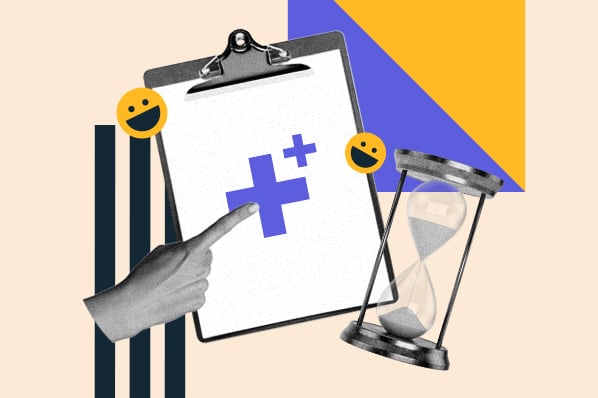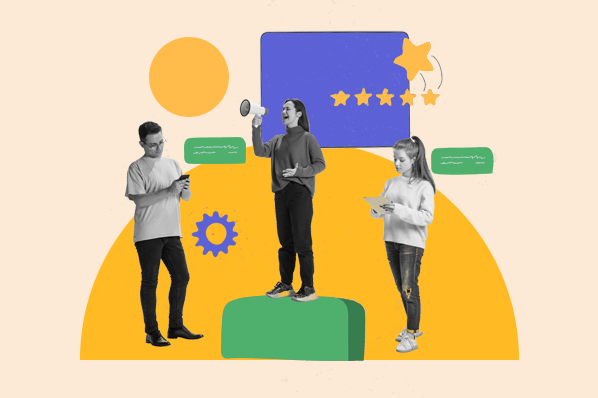What is customer effort?
In short, customer effort reflects how easy it is for customers to be successful with your product or service.
Customers expel effort at each touchpoint they have with a business, including:
- Subscription
- Account creation
- Product search
- Checkout
- Service interactions
- Support resources, such as FAQ pages or knowledge base
An easy journey requires minimum customer effort and is likely to leave them satisfied. If, however, contacting support becomes a complex process where the customer is transferred from one agent to another and needs to repeat their story each time, their effort increases while satisfaction plummets.
To gain an understanding of how easy it is for customers to interact with your business, there is an important metric called Customer Effort Score, or CES. It gives valuable insights into how you are doing in terms of customer effort and what needs to be improved.
How to Measure Customer Effort
It's a good idea to monitor and gauge customer effort on a regular basis to catch any flaws before they create a significant customer churn.
Gather Feedback
Customer feedback is the source of CES data. To calculate your Customer Effort Score, you need to ask customers directly about how easy their experience was. Of course, through feedback, you aren't getting all the information, since it's difficult to gather it at each touchpoint.
However, if you ask customers for feedback at the closing of a support chat or after checkout, they are quite likely to respond. Just ask a simple question, like the following:

Learn From Exiting Customers
You can also get customer effort data from customers who decide to stop doing business with you. Offer them an exit survey when they unsubscribe or opt not to renew their plan with you. Include questions related to the easiness of experience to see if high customer effort might have been the reason for their leaving.
Analyze the Customer Journey
In addition to asking customers for feedback, you can do your own research by following the journey your customers take with you. Identify the main touch-points and interactions and see how much effort customers need to take at each of them.
Is it easy to browse your website or search your product catalog? Do you ask for too many details on your subscription form? Is your checkout quick and intuitive? Answers to these questions may help you estimate the effort customers take to do business with you.
Support your analysis with the corresponding metrics, such as bounce rate and cart abandonment rate. These metrics can help you pinpoint your user flow issues.
Use Support Data
Your support system can yield a wealth of customer effort data. Analyze the questions and issues customers describe in their emails, support tickets, or the in-app chat. Pay attention to the issues that occur often — they point to things you might need to improve to reduce customer effort.
For example, if you see lots of questions about how to update account information, this suggests that account management flows need revision.
How to Reduce Customer Effort
When you have measured your Customer Effort Score, you might see that you need to improve the experience you create for your customers to reduce effort and increase satisfaction. The seven tips below suggest how to do it.
1. Create intuitive user journeys.
Analyzing your existing user journeys together with the support data and abandonment rate, you might be able to see where customers tend to get stuck. If, for example, you are getting lots of requests for assistance when tracking the delivery, you could consider altering your support materials so customers have an easier time understanding how to track.
On the other hand, a high cart abandonment rate suggests a difficult or non-transparent checkout.
Once you identify the problem, you are halfway to resolving it. You'll want to update the user journey to eliminate extra effort and create smooth and intuitive flows.
For instance, to optimize your checkout process and reduce effort, consider these improvements:
- Offer guest checkout. It may be tempting to harvest all those emails, but allowing customers to checkout without an account may bring better revenues at the end of the day.
- Make a one-page checkout journey. When the customer can see all their details at once — from the cart content to the delivery address — it is easier to verify that all information is correct.
- Allow free returns, if possible. For customers, especially first-time customers, a cumbersome return process can be too much effort.
2. Simplify interactions at each touchpoint.
Make everything as easy for the customer as possible. Display your contact details prominently, make links to FAQs and knowledge base visible, and set up your chat widget where it is easy to find and use. Simplicity is among the main factors determining the level of customer effort.
At the same time, you'll want to streamline your customer support process to ensure a quick connection to the right agent. There are few things customers hate more than being forced to repeat their story several times, so try to pre-screen all inquiries to identify the correct subject-matter experts.
3. Leverage self-service resources.
Customers love it when they can find answers to their questions on their own – in fact, 67% of customers prefer self-service over speaking to a service rep. It's always much quicker and easier than contacting support. Therefore, maintaining effective self-service resources, such as a knowledge base, a FAQ page, or a set of tutorials, is a great step toward reducing customer effort.
To make self-service resources work, follow some basic guidelines:
- Make them easily visible and accessible
- Fill them with clear and informative content
- Update them regularly based on both your product development and customer requests
See, for example, how YouTube does it. The video platform organizes all its self-service resources on one clear and well-arranged page. Users can browse the FAQs, ask the YouTube community for assistance, or contact the Help Center, if self-service resources cannot resolve the issue.

4. Use automation.
Automation of customer service processes can reduce customer effort significantly. Implementing a chatbot as the first line of customer support, on the one hand, helps to forward requests to the qualified agents who can provide expert assistance, and, on the other hand, eases the load on the support team.
Another automation tool that can both reduce customer effort and increase the resolution rate is a ticketing system allowing customers to create tickets whenever they have issues. Such a system automatically forwards tickets to the corresponding departments or experts and informs the customer of any status changes.
Also, consider using an effective CRM system. It allows synchronizing customer data between different departments and providing better service. As a result, customers take less effort to achieve success and are more satisfied.
5. Optimize for mobility.
Mobile users are gradually becoming the main target audience for most businesses. In 2022, mobile devices generated 57% of the entire global internet traffic.

This trend of preferred mobile use is steadily growing. People love the opportunity to use their mobile apps for everything, as it saves tons of time and allows getting things done on the run. You can check your email over breakfast, shop for clothes on the way to the office, and make payments while at your hairdresser's.
Optimizing your resources for mobile is going to earn you customers' appreciation and satisfaction. The ease and quickness of the mobile experience is a great effort-reducing factor.
6. Go omnichannel.
A low-effort experience includes the ability to communicate with the business over the preferred channel or switch between channels seamlessly. The omnichannel approach includes access to the customer's previous history of interactions so that their data is easily available upon each contact. Service agents can immediately see all the previous purchases, assistance requests, and support tickets that the customer made in the past via all channels, and do not need to ask the customer to repeat anything.
An omnichannel setup reduces the time needed to resolve customer issues and increases their satisfaction. Of course, its implementation requires thorough planning and investment of resources — integrating multiple communication channels, connecting them via the CRM system, and choosing the right email client. A good idea may be to join all your email and social media accounts in a single client, such as Shift and its alternatives, for easier monitoring and management.
At the end of the day, all these investments are going to pay back in spades. The effortless customer experience created by the omnichannel system can win you loyal customers and higher sales.
7. Resolve issues on first contact.
When the customer only needs to reach out to the company once, their effort is, obviously, reduced. Moreover, when it takes only one call or chat to fix the problem or get the answer to the question, the customer is better satisfied and likely to remain loyal to the brand. This is why the First Call Resolution, or FCR, is so important.
There are many factors contributing to increasing the FCR rate:
- Connecting the customer to the right SME from the very beginning
- Giving the agents enough authority to resolve customer issues independently
- Providing the support agents with complete customer data
- Empowering the support agents with effective tools
In addition, you can increase your FCR by training the support team to be proactive in their communications with customers and try to predict further issues. For example, if during a support chat, the customer asks to change their billing address, the agent might suggest updating the delivery instructions, too, to keep all data in sync. This can save the customer a second chat and, as a result, reduce their effort.
Customer loyalty depends not only on the quality of your product or service but also on how easy it is to use it. Effortless experiences make customer journeys pleasant and rewarding, turning them into loyal, long-term advocates.
Customer Loyalty
.png?width=112&height=112&name=Image%20Hackathon%20%E2%80%93%20Vertical%20(85).png)


-4.png)



-1.webp)

![How & Why Loyalty Punch Cards Attract Customers to Your Brand [+ Examples]](https://53.fs1.hubspotusercontent-na1.net/hubfs/53/customer-loyalty-punch-card_6.webp)


